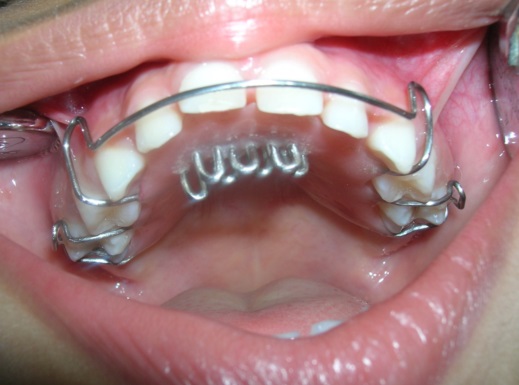 Example of an anti-thumb sucking device. File photo.
Example of an anti-thumb sucking device. File photo.
A local male dentist, referred to as Dr. L.E.H, has received a warning from the Health Professions Appeal and Review Board after a four year old ended up in hospital after receiving an anti-thumb sucking appliance.
The review was held on January 21, in North Bay.
According to the Board report, Dr. H., is a general dentist, who worked as a locum dentist in the office of another practitioner who was on leave.
The patient was a four-year-old at the time who first saw Dr. H. with his mother on August 27, 2012 for assessment of a thumb sucking habit. Options were discussed and an appliance was chosen.
The next day, the patient returned with his father. Ms S.H., a dental hygienist who worked with Dr. H., then took impressions.
On September 18, 2012, Ms. H. cemented an anti-thumb sucking device in the patient’s mouth. Before the patient left, Dr. H., who was in the adjacent operatory, reviewed intraoral photographs of the patient’s mouth and the placement of the appliance. Based on this review and the report of the hygienist, Dr. H. was satisfied with the care provided.
The next day, the patient’s grandmother phoned Dr. H.’s office requesting a follow-up appointment, which was scheduled for later that day at 4 p.m.
The patient came with his sister and was seen by Ms H. The sister advised the patient had been drooling and had not had anything to eat or drink since insertion of the appliance. Ms H. noted the patient was “wan and lethargic” but did not appear to be in physical or mental distress and was coherent and communicative. She noted he walked to the washroom and the toy box on his own.
Ms H. called the patient’s father who, according to Ms H., asked that she leave the appliance in. (The Applicant maintains he was advised by the parents that Dr. H.’s office would not remove the appliance.) Ms H. asked the patient’s father to call the office the next day to inform them of the patient’s progress. Ms H. spoke with Dr. H. and he was satisfied, based on her report, that appropriate care had been provided, especially given the appliance had only been inserted the previous day.
At 3:00 a.m. on September 20, the patient’s mother brought him to the emergency department at North Bay Regional Health Centre. The Applicant, a staff emergency physician at the hospital, noted that upon arrival, the patient was significantly dehydrated with metabolic acidosis and altered mental status. The patient required intravenous resuscitation and admission for failure to thrive.
According to the hospital records, in addition to drooling and not eating or drinking, the patient had not been sleeping and was vomiting frequently. However, Dr. H. and Ms H. stated that this information about the patient not sleeping and vomiting frequently was not provided to them.
Special arrangements were made to grant hospital privileges to Ms H. so that she could remove the appliance from the patient’s mouth, which she did in the early afternoon that day.
The child was kept in hospital until September 22.
In the Board's decision it noted:
- It is the Respondent’s professional responsibility to formulate treatment options based on the exercise of his clinical judgment; he should not allow pressure from patients or their caregivers to dictate his treatment decisions.
- The Respondent should be reluctant to employ anti-thumb sucking appliances for very young patients who may be unable to understand or tolerate the treatment provided.
- Where the Respondent employs a dental hygienist to perform orthodontic procedures, he must ensure that he adequately supervises and verifies the appropriateness of the treatment provided. The Respondent should, wherever possible, make such confirmation through direct clinical observation of the patient.
- It is the Respondent’s professional responsibility to sign all prescriptions for orthodontic appliances being fabricated for his patients. It is inappropriate for any such prescriptions to be signed by a member of his staff.
- It is incumbent upon the Respondent to take responsibility for the ongoing care of his patients and for concerns or complications arising from his treatment. It is inappropriate for the Respondent to rely exclusively on observations from his staff members or to delegate dental decision making to a staff member or a patient’s parent. The Respondent’s responsibilities in this regard are heightened where he has already identified potential concerns with the treatment being provided and where the patient is young or potentially vulnerable.
See the full report here:


